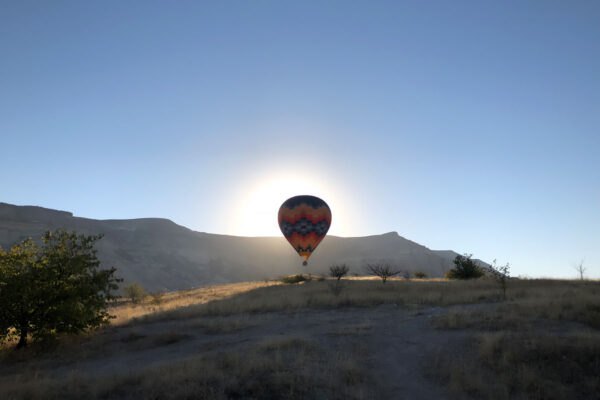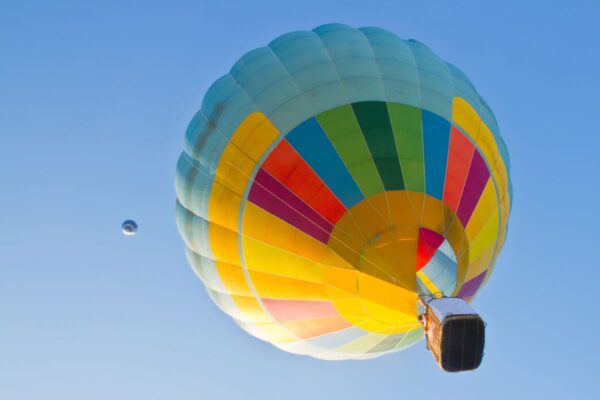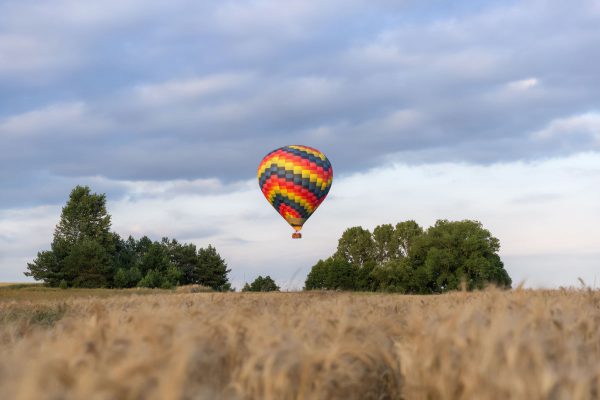Acrophobia, known as fear of heights, affects nearly one in twenty people in the population. Paradoxically, many individuals struggling with this issue discover an unexpected sense of safety during a hot air balloon flight. This phenomenon intrigues experts and raises questions about the psychological mechanisms behind this paradox.
The balloon basket creates a unique environment that fundamentally differs from other height-related situations. The enclosed space surrounded by walls eliminates direct visual contact with the ground, while the gentle ascent replaces the terrifying feeling of climbing. The stable structure of the basket and slow vertical movements have a calming effect on people dealing with acrophobia.
Scientific research on the topic reveals fascinating neurobiological and psychological mechanisms. Controlled flight conditions, a sense of security in the enclosed space, and specific responses of the vestibular system make the balloon an unexpected ally in combating fear of heights. Understanding these processes leads to practical applications in therapy and rehabilitation for individuals affected by acrophobia.
Psychological Mechanisms for Coping with Fear of Heights
The human psyche has complex defense mechanisms that help manage fear of heights. During a balloon flight, specific cognitive processes are activated that modulate emotional and physiological responses. The brain interprets the situation inside the balloon basket as significantly less threatening than traditional height exposures, activating natural adaptive mechanisms. A key element in psychologically coping with fear is the cognitive appraisal of threat.
Inside the balloon basket, a person experiences a reduced sense of control over the situation, which paradoxically leads to anxiety reduction. Delegating responsibility to an experienced pilot eliminates the pressure of making safety-related decisions. The change in context leads to a fundamentally different risk assessment by the nervous system. The space within the balloon basket activates different brain areas responsible for processing spatial information.
How Control Over the Situation Affects Anxiety Levels
A sense of control over the situation plays a fundamental role in shaping the intensity of fear of heights. Psychological studies show that excessive control can paradoxically increase anxiety levels in people with acrophobia. In the balloon basket, there is a conscious transfer of responsibility to a qualified pilot, which reduces pressure related to decision-making. Delegating control creates a psychological buffer protecting against emotional overload.
Passengers can focus on positive aspects of the experience, such as admiring the landscape or feeling calm. Eliminating the need to monitor threats and plan defensive reactions allows the mind to naturally relax. The process of transferring control requires trust, which is built through transparent communication from the pilot and demonstration of their competence. Professional flight preparation, thorough safety instructions, and calm behavior from the pilot strengthen passengers’ sense of security.
The Role of the Sense of Security in an Enclosed Space
The balloon basket’s structure creates a psychologically comfortable space that mimics familiar and safe environments from everyday life. The surrounding walls of the basket act as a natural protective barrier, eliminating the sense of open space typical of other height exposures. The enclosure activates primal safety instincts related to protection and shelter. The height of the basket walls, usually reaching waist or chest level, provides a physical barrier without limiting visibility.
Elements Affecting Psychological Comfort:
- Stable wicker or rattan construction providing solid support
- Natural and tactile-friendly materials
- Appropriate wall height preventing accidental falls
- Ergonomic space tailored to passengers’ needs
These structural elements work together to create an atmosphere of safety and comfort during the flight. Natural materials not only ensure the durability of the structure but also have a calming effect on the senses through pleasant tactile contact. Properly designed wall height eliminates fears related to accidentally falling out of the basket while allowing for unobstructed enjoyment of the scenery.
The enclosed space effect is also enhanced by the presence of other passengers and the pilot. The social aspect of the experience reduces isolation often accompanying fear of heights. Sharing the space with others activates mechanisms of social support and normalization of the situation.
The Impact of Basket Stability on Threat Perception
The stable construction of the balloon basket fundamentally changes how the brain processes signals related to height and potential danger. Unlike unstable platforms or building edges, the basket moves smoothly and predictably, eliminating sudden movements that could trigger anxiety reactions. Physical stability directly translates into psychological comfort and stress reduction. Even weight distribution in the basket and its low design provide natural balance during flight.
Passengers do not experience feelings of wobbliness or instability characteristic of high platforms. Physical support from leaning against the basket walls provides additional stabilization points, reinforcing a sense of security. The aerodynamic properties of the entire balloon system ensure an exceptionally smooth flight. The absence of vibrations, sudden gusts, or directional changes eliminates physical signals that might activate defensive body responses.
Differences Between Fear of Heights and Balloon Space
Traditional situations that trigger fear of heights differ fundamentally from conditions inside a balloon basket. Classic height exposures are characterized by direct visibility of the ground surface, constant contact with building structures, and awareness of climbing or standing on a fixed platform. The balloon eliminates most fear triggers, creating a unique space of psychological comfort. The difference in perception results from different mechanisms activating fear of heights.
On fixed structures, the brain calculates the risk of falling based on the physical law of gravity and the potential consequences of contact with the ground. In a balloon, these calculations become irrelevant due to the nature of the flight and specific safety conditions. The change in context leads to a fundamentally different risk assessment by the nervous system. The balloon basket space activates different areas of the brain responsible for processing spatial information.
Factors reducing fear:
- Elimination of direct visibility of the ground by the basket structure
- Gentle lifting process instead of active climbing
- Stable movement conditions without sudden changes and vibrations
- Psychological sense of security in an enclosed space
- Delegation of control to an experienced pilot
Each of these factors contributes to creating a unique environment that minimizes traditional fear triggers. The combination of physical and psychological elements creates conditions conducive to positive experiences at height. Sequential elimination of sources of fear allows people with acrophobia to gradually become accustomed to being at height in comfortable conditions.
No direct visual contact with the ground
The balloon basket’s design strategically limits direct visual contact with the ground surface, which is one of the most important factors reducing fear of heights. The basket walls, at an appropriate height, block the lower area of the field of vision where there is usually a perspective on the ground that triggers fear responses. Eliminating this visual trigger allows the brain to process height information more calmly. Perception psychology indicates that a direct view of the ground from a height activates primal threat assessment mechanisms related to falling.
The brain automatically calculates distance and potential consequences of a fall, which leads to triggering a stress response. In the balloon basket, these calculations are interrupted by physical limitation of the field of vision. Limited visual contact does not completely eliminate awareness of height but changes its perception. Instead of focusing on immediate fall danger, attention shifts to horizontal panoramas and distant landscapes.
The sensation of floating instead of climbing
The balloon’s ascent process fundamentally differs from traditional climbing to height, which is crucial for people with acrophobia. During climbing, the brain constantly monitors progress and calculates risks associated with each additional meter gained in height. In a balloon, ascent is gentle, almost imperceptible, eliminating real-time awareness of increasing altitude. The gradual nature of ascent allows the body to adapt progressively to changing conditions.
The absence of sudden altitude changes eliminates shock reactions often accompanying rapid vertical movement. The balance system can calmly adjust to a new position in space without triggering alarm defense mechanisms. Physiologically, the floating process activates different receptors in the inner ear than climbing does. Instead of signals related to actively overcoming gravity, the body receives information about gentle movement through space.
| Traditional Climbing | Balloon Ascent | Impact on Anxiety |
|---|---|---|
| Active physical effort | Passive movement | Stress reduction |
| Awareness of every meter | Almost imperceptible ascent | Lower anxiety activation |
| Real-time risk calculation | No awareness of increasing risk | Calmer situation assessment |
Comparing two forms of vertical movement clearly shows the advantages of balloon flight for people with acrophobia. The passive nature of ascent eliminates the active fear associated with taking risks and controlling the situation. The body can focus on adapting to new conditions instead of constantly assessing threats. The lack of conscious decision-making about increasing altitude reduces responsibility and related stress.
The Importance of Physical Barriers in Reducing Fear
Physical barriers in the form of balloon basket walls play a fundamental role in reducing fear of heights by creating a psychological sense of safety and control. The height of the basket walls, usually reaching the waist or chest of an adult, provides sufficient protection against accidental falls, eliminating one of the main sources of fear. The physical barrier also acts as a psychological buffer, creating a clear boundary between the safe space inside the basket and the potentially threatening external space.
The material used for the barriers further influences passengers’ psychological comfort. Natural wicker or rattan provide pleasant-to-the-touch surfaces that enhance the sense of security by activating positive tactile associations. A solid construction eliminates concerns related to protective durability, allowing full trust in the physical barrier. The ergonomic height of the barriers enables unobstructed viewing of landscapes without compromising the feeling of safety.
The Impact of Vertical Movement on Anxiety Reactions
The characteristics of vertical movement in a balloon differ radically from other forms of vertical transport, which directly affects anxiety responses in the body. Smooth ascent and descent eliminate sudden acceleration changes typical for elevators or lifting platforms. The absence of abrupt movements allows the balance system to calmly adjust to changing conditions without triggering alarm mechanisms. The pace of vertical movement in a balloon is natural and resembles biological rhythms, promoting relaxation rather than causing anxiety.
Characteristics of Balloon Movement:
- Slow altitude changes allowing gradual psychophysiological adaptation
- Predictability of movement direction providing a sense of control over the situation
- Elimination of surprise elements reducing stress levels
- Natural pace resembling biological rhythms
The specified features of balloon movement create optimal conditions for people with fear of heights. The possibility for psychophysiological adaptation allows the body to calmly adjust to new conditions without activating defense mechanisms. Predictability of flight trajectory eliminates uncertainty and related stress, while the natural pace harmonizes with internal biological rhythms.
The body has time to process new sensory information and adjust reactions to the current situation. Predictability of vertical movement further reduces anxiety by eliminating surprise elements. Passengers can observe the ascent and descent process, which provides a sense of control over the situation.
Tip: During the first flight, focus on observing gentle changes in altitude and consciously note the difference in sensations compared to riding an elevator or climbing stairs.
Neurobiological Foundations of Acrophobia and Its Exceptions
Acrophobia has deep neurobiological roots connected to evolutionary survival mechanisms of humanity. The brain contains specialized structures responsible for detecting and responding to height-related threats, which for millennia protected our ancestors from fatal falls. The amygdala, thalamus, and midbrain form a complex network that processes spatial information and generates appropriate behavioral responses. In individuals with acrophobia, this system shows hypersensitivity, reacting with anxiety to objectively safe situations.
Neuroimaging studies reveal increased activity in areas responsible for fear processing and threat assessment. At the same time, decreased activity is observed in regions related to rational risk evaluation and emotional control, leading to the dominance of irrational fear responses over logical thinking. The balloon basket environment activates different neurological pathways than traditional height exposures. Specific flight conditions affect the functioning of the balance system, depth perception, and visual information processing in a way that bypasses typical acrophobia triggers.
Functioning of the Balance System Under Different Conditions
The balance system, located in the inner ear, plays a key role in height perception and generating anxiety responses in people with acrophobia. In traditional height-related situations, the vestibular system receives intense signals related to orientation relative to gravity and potential loss of balance threat. This information is processed by the brain as alarm signals, triggering a cascade of stress reactions. In the balloon basket, the balance system operates under different physiological conditions.
The smooth movement of the balloon eliminates sudden position changes and accelerations that normally activate defensive mechanisms. The stable platform of the basket provides constant reference points for proprioception, allowing the balance system to function calmly without generating alarm signals. Neurological studies indicate that different types of motion activate distinct areas of the vestibular system. Balloon flight stimulates receptors responsible for detecting linear acceleration gently and rhythmically, resembling natural rocking movements.
Components of the Balance System:
- Otolith receptors responding to position changes relative to gravity
- Semi-circular canals detecting rotational head movements
- Proprioception informing about body position in space
- Visual integration coordinating visual information with balance
The cooperation of these components during balloon flight proceeds harmoniously and without disruption. Gentle stimulation does not overload any system, allowing natural psychophysiological balance to be maintained. The absence of conflicts between different sensory information sources eliminates disorientation and related discomfort.
Brain Reactions to Depth and Distance Perception
Depth and distance perception in the brain are processed by specialized areas of the visual cortex, which in individuals with acrophobia may show excessive reactivity to height-related signals. In traditional height situations, the brain analyzes linear perspective, object size, and motion parallax, generating a precise estimate of the distance to the ground. In people with acrophobia, this process often leads to an overestimation of danger and triggers intense anxiety reactions. In the balloon basket, depth perception undergoes significant modification due to altered observation conditions.
The flight altitude eliminates the possibility of accurately estimating the distance to the ground through traditional visual cues. The brain receives less precise depth information, which paradoxically reduces activation of areas responsible for assessing fall-related danger. The balloon’s movements further disrupt standard depth processing mechanisms by introducing a dynamic element to perception. The changing perspective makes it difficult for the brain to perform precise distance calculations, leading to a reduction in automatic anxiety responses.
Adaptive Mechanisms in Unusual Situations
The human brain has an extraordinary ability to adapt to unusual situations thanks to neuroplasticity and the creation of new response patterns. In the context of balloon flight, adaptive mechanisms allow for transforming a potentially stressful height situation into a positive experience. The adaptation process includes modifying activity in key brain areas responsible for processing anxiety and threat assessment. Short-term adaptive mechanisms engage within the first minutes of flight when the brain recognizes the absence of real danger in the balloon basket environment.
The amygdala, the main center for fear processing, gradually decreases its activity in response to positive signals from other brain regions. At the same time, activity increases in areas associated with reward and pleasure, creating positive associations with the height experience. Long-term adaptive effects can lead to lasting changes in reactions to heights. Positive experiences from balloon flights create new neural pathways that can be activated in future height-related situations.
Tip: People with acrophobia should consciously focus on positive sensations and views during flight, which will help the brain form new, beneficial associations with heights.
Practical Applications in Height Anxiety Therapy
The therapeutic use of balloon flights in treating acrophobia represents an innovative approach in behavioral psychotherapy. The specific conditions of flight create an ideal space for controlled exposure to heights in a safe and comfortable environment. Therapists utilize the unique properties of the balloon basket to conduct gradual desensitization, allowing patients positive experiences related to height without traditional anxiety triggers. The method combines elements of exposure therapy with relaxation techniques, creating a holistic approach to treating acrophobia.
Controlled flight conditions allow the therapist to adjust the intensity of exposure to the individual needs of the patient. The ability to gradually increase altitude and flight duration enables personalization of the therapeutic process according to each patient’s adaptation pace. Clinical studies confirm the effectiveness of the method in reducing acrophobia symptoms and improving patients’ quality of life. Positive experiences from balloon flights lead to generalization of therapeutic effects to other height-related situations.
Use of Balloon Flights in Gradual Exposure
Exposure therapy is the gold standard in treating specific phobias, and balloon flights offer a unique platform for its implementation in cases of acrophobia. Gradual exposure in the context of balloon flight allows precise control over the intensity of anxiety stimuli by modifying altitude, duration, and flight conditions. Therapists can start with low altitudes and short flights, progressively increasing parameters according to patient progress. The exposure process in a balloon eliminates many stress-inducing factors typical of traditional therapeutic methods.
The lack of direct visual contact with the ground, basket stability, and gentle movement create optimal conditions for initial exposures to height. Patients can focus on positive aspects of the experience without overwhelming anxiety reactions. The flexibility of the method allows adaptation to different types of acrophobia and symptom severity levels. For patients with mild fear of heights, short flights at low altitudes may be sufficient.
Stages of Exposure Therapy:
- Preparatory phase involving familiarization with basket construction and safety procedures
- Initial exposure including short flights at altitudes of 50-100 meters
- Gradual increase through progressive altitude elevation and extended flight time
- Consolidation of effects through repeated exposures to reinforce progress
A structured approach to exposure therapy ensures systematic progress in overcoming fear of heights. Each stage builds on previous achievements, creating a solid foundation for further development. The gradual nature of the process allows patients comfortable adaptation to each level of exposure intensity. The ability to tailor therapy pace to individual needs increases the likelihood of treatment success.
Building Trust Through Positive Experiences
Building trust is a fundamental element of the therapeutic process in treating acrophobia. Positive experiences related to balloon flight create new neural pathways that compete with previously established anxiety patterns. Each successful flight strengthens the patient’s sense of self-efficacy and their ability to cope with height-related situations. The trust-building process begins during flight preparations through thorough discussion of safety procedures and balloon construction.
Patients receive detailed information about the equipment operation rules, pilot qualifications, and balloon flight safety statistics. Transparency and open communication eliminate uncertainty and concerns related to an unfamiliar experience. During the flight, positive emotions associated with admiring the landscapes and feeling calm strengthen new associations with height. The brain learns to associate being at height with pleasure and relaxation instead of fear and threat.
Combining Relaxation with Confronting Fear
The integration of relaxation techniques with exposure to height during a balloon flight creates a synergistic therapeutic effect. The calm flight conditions naturally promote relaxation, allowing the implementation of various stress reduction techniques directly in a potentially anxiety-provoking situation. Patients learn to apply diaphragmatic breathing, progressive muscle relaxation, and mindfulness techniques in real height exposure conditions. The physiological effects of relaxation act antagonistically to fear responses, creating a state incompatible with fear.
Activation of the parasympathetic nervous system during the use of relaxation techniques inhibits stress reactions characteristic of acrophobia. Patients directly experience that it is possible to feel calm and comfortable even at significant heights. Regular practice of relaxation in the context of balloon flight leads to automation of responses in other height-related situations. The brain learns to activate calming mechanisms in response to height-related stimuli, which forms the foundation for long-term coping with acrophobia.
Long-Term Therapeutic Effects
The long-term effects of therapy using balloon flights go beyond simple reduction of fear of heights, including improvement in overall quality of life and increased patient confidence. Supplementary studies indicate that positive therapeutic effects persist for many months after treatment completion. Patients show lasting reduction in avoidance of height-related situations and increased readiness to take on new challenges. Generalization of therapeutic effects covers various height-related contexts in daily life.
Patients report greater comfort when using balconies, riding cable cars, or staying in tall buildings. Positive experiences from balloon flights create a reference point that helps assess other height situations as less threatening. Brain neuroplasticity ensures the durability of therapeutic changes through consolidation of new response patterns. Multiple positive exposures to height in the context of balloon flight lead to structural changes in neural connections responsible for fear processing.
Tip: Maximizing therapeutic effects requires regularly recalling positive balloon flight experiences and consciously applying learned relaxation techniques in everyday situations involving heights.
Professional Balloon Flights with ProBallooning
ProBallooning offers a wide range of balloon flight experiences tailored to various needs and occasions. The services are aimed at those seeking unforgettable adventures and unique memories high above the ground. Each flight combines safety, comfort, and unparalleled emotions experienced in the skies.
The ProBallooning team consists of experienced pilots holding airline operator certificates. Regular technical inspections of balloons and a high safety standard guarantee a peaceful experience for every participant. A personalized approach ensures the flight is adapted to individual expectations and preferences.
Professional Balloon Flights
ProBallooning conducts balloon flights in the picturesque areas around Warsaw, Radom, and Łódź. The offered packages include experiences for everyone.
- Scenic balloon flights allow you to admire the beauty of Mazovia from a bird’s-eye view. During the journey, you can see the meanders of the Vistula and Pilica Rivers winding through green landscapes. Bolimów Landscape Park, the Castle of the Mazovian Dukes in Czersk, and Domaniowski Reservoir appear in all their splendor.
- Private balloon flights offer an exclusive adventure for those seeking intimate experiences with their closest companions. The intimate atmosphere allows for route customization according to individual preferences and relaxed enjoyment of the scenery.
- Family balloon trips provide an opportunity to spend time with loved ones in a peaceful setting, away from everyday hustle and bustle. Sharing this adventure strengthens family bonds and creates lifelong memories.
- Balloon engagement flights are designed for couples wishing to celebrate special moments in an unforgettable way. Love lifted above everyday life finds its perfect setting among clouds and an expansive horizon.
A balloon flight as a gift is a unique way to give someone more than just a material item. Floating above the ground and admiring picturesque landscapes is an experience that stays in memory forever.
Small passenger groups ensure comfort and space for every participant. Each flight maintains a high safety standard through regular technical inspections and the commitment of experienced pilots.
ProBallooning Company
ProBallooning Company was founded out of a deep passion for ballooning and a desire to share this experience. The founder is a pilot with over eight years of experience who has completed about five hundred flights worldwide. ProBallooning focuses on providing the highest quality service to every client and nurturing the tradition of aerial sports.
ProBallooning is a member of the Polish National Team and regularly participates in the Polish Cup and World Championships. The company’s involvement in the international ballooning arena demonstrates the professionalism and dedication of the team. The main goal of ProBallooning is to promote and popularize ballooning for an increasing number of people throughout Poland.
The ProBallooning team also includes an experienced pilot from Brazil, coming from a family with a long ballooning tradition spanning three decades. The international experience gained through participation in competitions from Brazil through Japan and the United States to Australia enriches ProBallooning’s perspective. This global knowledge translates into exceptional quality and innovation in the services offered by ProBallooning.
Customer Reviews and Satisfaction
People using ProBallooning’s services express deep satisfaction with the quality of the experience and the professionalism of the team. Balloon flights become memories for entire families, couples, and friends who share this extraordinary adventure together. Participants consistently recommend ProBallooning’s professionalism, commitment, and attention to every detail of service.
Passengers highlight the beautiful views from above and the unique atmosphere during the flight. A balloon flight chosen as a gift brings exceptional joy to those receiving it. Memories from the flight last a lifetime, leaving a lasting impression on participants’ emotions and hearts.
Book your balloon flight experience today and contact the ProBallooning team. Choose from available packages the one that best matches your dreams. ProBallooning invites you to book and offers support in selecting the perfect flight for you and your loved ones.
Physical and Technical Factors Affecting Comfort
The design and technical properties of a hot air balloon are fundamental to passengers’ psychological comfort, especially for those struggling with acrophobia. Every element of the balloon system has been designed with safety and stability in mind, which directly reduces fear of heights. Engineering solutions applied in building the balloon create optimal conditions for positive experiences at altitude. Materials used in basket construction, altitude control systems, and atmospheric conditions all influence flight quality and passenger comfort levels.
Professional balloons are designed according to strict safety standards, eliminating most technical hazards that could cause anxiety in people with a fear of heights. Advanced control systems allow pilots to precisely manage flight parameters, ensuring smoothness and predictability of movement. The technical aspects of balloon flight differ significantly from other forms of air transport, eliminating many stress-inducing factors typical of airplanes or helicopters.
Technical advantages of the balloon:
- No engine and related vibrations provide a quiet flight
- Natural use of air currents creates a calm atmosphere
- Passive nature of the flight allows focus on positive aspects
- Advanced safety systems eliminate most technical hazards
The listed technical advantages work together to create a unique aviation environment that minimizes factors that may trigger anxiety in sensitive passengers. Quiet flight eliminates noise that can be stressful, while the natural use of air currents ensures harmonious movement through space. The passive nature of the flight allows full concentration on the aesthetic and relaxing aspects of the experience.
Basket construction and its impact on stability
The balloon basket is a key element affecting passenger safety and comfort during the flight. Traditional construction from natural wicker or rattan provides an optimal combination of lightness, durability, and flexibility. The materials absorb minor vibrations and shocks, eliminating unpleasant sensations that could cause anxiety in people with acrophobia. The natural woven structure disperses mechanical forces, ensuring a smooth and stable flight experience. Basket dimensions are precisely calculated to ensure optimal stability during various phases of the flight.
A low center of gravity and wide base eliminate the tendency to sway or tilt. Ergonomic wall height, usually reaching an adult’s waist, provides a psychological sense of security without limiting landscape visibility. The basket’s internal structure often includes partitions separating individual passengers, which further increases stability and comfort. Space division eliminates accidental contact between passengers during turbulence and provides each person with their own safe zone.
| Construction Element | Impact on Stability | Benefit for People with Acrophobia |
|---|---|---|
| Natural wicker | Vibration absorption | Elimination of unsettling vibrations |
| Low center of gravity | Reduction of swaying | Sense of stability |
| Ergonomic walls | Physical protective barrier | Increased psychological safety |
The table presents the key structural elements of the basket and their direct impact on the comfort of individuals with a fear of heights. Each component has been designed to maximize the sense of safety and stability. The synergistic action of all elements creates an optimal environment for people struggling with acrophobia, eliminating most physical factors that could trigger anxiety or discomfort during the flight.
Height and ascent rate control
Height control systems in modern balloons allow pilots to precisely manage flight parameters, which is crucial for the comfort of passengers with a fear of heights. Gas burners enable accurate dosing of the amount of hot air entering the envelope, resulting in controlled ascent or descent. The ability to maintain a constant altitude for an extended period allows passengers to gradually adapt to flight conditions. The balloon’s ascent rate is naturally limited by physics and safety principles, eliminating sudden altitude changes that could cause discomfort.
The typical ascent speed ranges from 1 to 3 meters per second, allowing the balance system to calmly adjust to changing conditions. The smooth nature of altitude changes minimizes activation of fear mechanisms related to sudden vertical movements. Experienced pilots use knowledge of local weather conditions to optimize the flight profile for passenger comfort. Choosing appropriate air layers with different wind speeds allows control not only over altitude but also over the flight trajectory.
Atmospheric conditions conducive to a calm flight
Optimal atmospheric conditions for balloon flights are characterized by stability and predictability, which directly affect the comfort of individuals with a fear of heights. The best conditions usually occur early in the morning or late in the afternoon when the atmosphere is most stable and wind speeds are minimal. The absence of strong air currents eliminates turbulence that could cause anxiety in passengers with acrophobia. Light surface winds not exceeding 10-15 kilometers per hour ensure gentle takeoffs and landings as well as a smooth overall flight experience.
Low thermal activity limits vertical air currents that could cause unpredictable balloon movements. Stable barometric conditions eliminate sudden changes in atmospheric pressure affecting balloon behavior. Atmospheric visibility also influences passengers’ psychological comfort. Clear air and good visibility allow for enjoying panoramic views, which distracts from potential height-related fears.
Optimal weather conditions:
- Wind speed maximum 10-15 km/h for optimal comfort
- Minimal thermal activity to eliminate turbulence
- Visibility over 10 kilometers for maximum visual experience
- Stable atmospheric pressure without sudden changes
- Time of day early morning or late afternoon for the best conditions
Adhering to the listed weather criteria ensures optimal conditions for balloon flights, especially beneficial for individuals with acrophobia. The combination of stable weather and the appropriate time of day creates ideal circumstances for positive experiences at altitude. Professional balloon operators carefully monitor atmospheric conditions to provide passengers with maximum comfort and safety during the flight.
Tip: People with acrophobia planning a balloon flight should choose days with stable weather conditions and consult with the operator about the optimal flight time for maximum comfort.
Summary
The phenomenon of safety felt by individuals with acrophobia in a balloon basket results from a combination of unique psychological, neurobiological, and technical factors. The basket’s design eliminates key fear triggers by limiting direct eye contact with the ground, providing physical protective barriers, and creating a stable space. The gentle nature of the balloon’s movement activates different brain areas than traditional height situations, bypassing typical fear-generating mechanisms.
The practical application of this knowledge in acrophobia therapy opens new perspectives for treating height anxiety. Controlled flight conditions create an ideal platform for gradual exposure, allowing patients positive experiences with heights without overwhelming fear responses. Long-term therapeutic effects go beyond simple symptom reduction, leading to fundamental changes in how height-related situations are perceived and responded to in daily life.
Sources:
- https://pmc.ncbi.nlm.nih.gov/articles/PMC7718183/
- https://pubmed.ncbi.nlm.nih.gov/28359010/
- https://onlinelibrary.wiley.com/doi/full/10.5694/mja16.00540
- https://www.frontiersin.org/journals/psychology/articles/10.3389/fpsyg.2022.919148/full
- https://www.frontiersin.org/journals/psychology/articles/10.3389/fpsyg.2021.671871/full
- https://www.nature.com/articles/s41467-024-48147-x
- https://www.sciencedirect.com/science/article/abs/pii/S0005791623000277
- https://pmc.ncbi.nlm.nih.gov/articles/PMC10025232/
- https://pmc.ncbi.nlm.nih.gov/articles/PMC9521642/
- https://www.sciencedirect.com/topics/neuroscience/acrophobia
- https://pmc.ncbi.nlm.nih.gov/articles/PMC6734202/
- https://pubmed.ncbi.nlm.nih.gov/40186999/
- https://www.frontiersin.org/journals/human-neuroscience/articles/10.3389/fnhum.2023.1229484/full
- https://clinicaltrials.gov/study/NCT03917433
- https://academic.oup.com/ptj/article/85/5/443/2805024
- https://www.nature.com/articles/s41746-021-00387-7
- https://en.wikipedia.org/wiki/Acrophobia
- https://www.medonet.pl/zdrowie,akrofobia—definicja–objawy–leczenie,artykul,1730047.html





